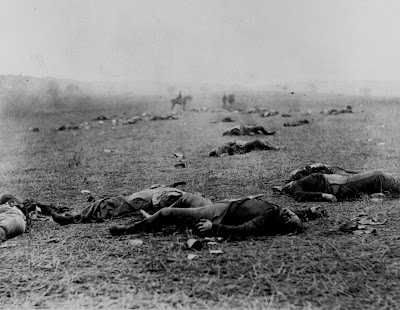 Oscar Gustav Rejlander , Two Ways of Life, 1858
Oscar Gustav Rejlander , Two Ways of Life, 1858
Henry Peach Robinson, Fading Away, 1858
Early art photographs mimicked styles and genres popularized by painting. For example, after he returned from the Crimean, Roger Fenton's art photography borrowed aspects from European painting, specifically Dutch and Flemish. In the mid-1800s, art photographers, like Rejlander and Robinson, promoted manipulated, handcrafted images. In fact, Robinson maintained that a successful art photograph exhibited as much handcraft and finesse as any other popular art medium, such as painting and sculpture. Robinson and Rejlander practiced multiple exposures, combination printing, and photographic staging. For example, Robinson's Fading Away (pictured above) was photographed in six separate negatives that were individually printed, cut out, and pasted to a single background. Next, the joinery was retouched, and the entire photo-collage was re-photographed, thereby ensuring a seamless print. Indeed, Robinson proved the most popular art photographer of the day.

Julia Margaret Cameron, Mary Ryan, 1866
Julia Margaret Cameron was another popular, early pictorialist. Her soft-focus portraits, which often incorportaed Biblical symbolism have earned her a place within photo history.

Peter Henry Emerson, Coming Home From the Marshes, 1888
In response to early Pictorialists, like Cameron, Rejlander, and Robinson, Perter Henry Emerson developed his own philosophy, which he coined "Naturalism." Emerson believed that true art photography should exploit the medium for the thing that it does best, picturing "the real". Hence, Emerson advocated for “realistic” non-manipulated photography, which pictured real people, not actors, and utilized soft focus (which he argued was closer to how people actually saw). In addition, Emerson praised photographic processes, such as photogravure and platinum, and promoted the concept of the photographic salon.
 Alfred Stieglitz, The Terminal, 1892 (platinum print)
Alfred Stieglitz, The Terminal, 1892 (platinum print)By 1890, Emerson declared Naturalism over, but before he put an end to his short-lived art movement, he deemed Alfred Stieglitz the next aficionado of art photography. Stieglitz, who was born in Hoboken, New Jersey, had recently returned to New York City from Germany where he studied engineering and photography. Upon his return to the States, he adopted Pictorialism and became a major figure in the New York art world.

Gertrude Käsebier, Blessed Art Thou among Women, 1899
In the late 1800s the Dry Plate Process had replaced the popular Wet Plate, and the amateur photographer (as opposed to the commercial/professional) became a prominent force within the photographic art world. One advantage of the dry plate was that it was pre-packaged, thereby making photography less cumbersome and allowing for more hobbyists. In addition, by 1888, Kodak introduced the first handheld camera model, called Kodak #1. In 1902, in order to distinguish himself and his practice from the mass of amateur photographers, Stieglitz brought together like-minded artists and formed a group called the Photo-Secessionists. That year the group published its objectives:
• To advance photography as applied to pictorial expression
• To draw together those Americans practicing or otherwise interested in the art.
• To hold from time to times, at varying places, exhibitions not necessarily limited to the productions of the Photo-Secessionists or to American work.
The group included popular photographers such as Gertrude Kasebier, Edward Steichen, Clarence White, and Alvin Langdon Coburn.

Steichen, Little Galleries of the Photo Secession, 1903 (platinum print)
The Photo Secessionists had a small gallery space, called 291 (after its address, 291 Broadway). At 291, Stieglitz exhibited, not only Photo-Secessionist work, but also other work by photographers and painters, including Picasso, Cezanne, and Matisse. Indeed, Alfred Stieglitz was not only responsible for bringing modern art to New York City, but he also helped make New York a major force in the art world.












![[grand-canyon-colorado2-1.jpg]](https://blogger.googleusercontent.com/img/b/R29vZ2xl/AVvXsEgdk5YNexLy7979CCrVQa9CA6MWpmlwc6gF69K-p3A1gRPpWV2VVYiBjSptTARQF2GmmUvHK3UNC8QRjztINJ1hSwmdVY-cAiFTd59zfO80btRsQcTWJ_C5rJpHrA6fKjJ8TuhpsndNm2P2/s1600/grand-canyon-colorado2-1.jpg) (left) William Henry Jackson (right Thomas Moran)
(left) William Henry Jackson (right Thomas Moran)




![[earliest-surv-dag-us.jpg]](https://blogger.googleusercontent.com/img/b/R29vZ2xl/AVvXsEhFXlm2gQ0nBujJC8XO84BAYkp9hH513D3z_lFphYSxKOpWnvgtQDk6nSM73PuJxTzp3fAy-dUW9rFrwX8gbK-RRwz68INCmv44xBTipDkepzXbWOwQxgxGGdNwu54YUyb01-31IUJRv56a/s1600/earliest-surv-dag-us.jpg)
![[camera-mfg.jpg]](https://blogger.googleusercontent.com/img/b/R29vZ2xl/AVvXsEgEFp3H4znncs4ObRgr6dtYIoXg62qMHZ8AAPk1D-oANxw0iLArwPTgFVdjCWybAPhP-3zh23m4DBMw63VpzR5m5dO4UD9j4ZtqvVnHZc8_mHf7QNzYIk_FrZYpK11ZZz_64iHuswTrg5V5/s1600/camera-mfg.jpg)
![[bradys-studio2.jpg]](https://blogger.googleusercontent.com/img/b/R29vZ2xl/AVvXsEgPp1KjemdnewE0n1Lpy9djJbGlIAM5y9p7MwDCnAVlwn-bzRHtWPq7rRg-Vgcy9YzHCHgca8jcExdM95q7qBpGEABk9dHGoLli5GfFuVPfgFiVL2EqhYc_gBkvzzoJdHwtjtk7sbTOeO9Y/s1600/bradys-studio2.jpg)
![[frederick-douglas.jpg]](https://blogger.googleusercontent.com/img/b/R29vZ2xl/AVvXsEiC6oMx4PVU7F-AML9RSR06m8pNhNwZu88DeydnFe5LJ0VDQp1XfwnhmcDdIbwimJeikf5ACl3AOS0tSXBzHbzDUF4uutf4-MB0VlHM1eOgBxlkA_OB1X2Pho46SyVEx_7D7DWAv4PEfDNo/s1600/frederick-douglas.jpg)


